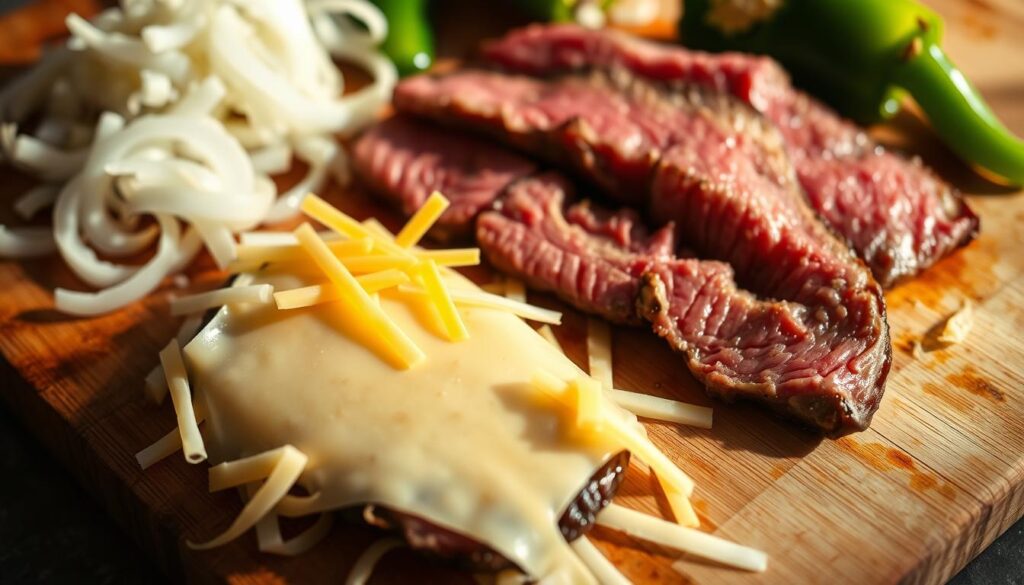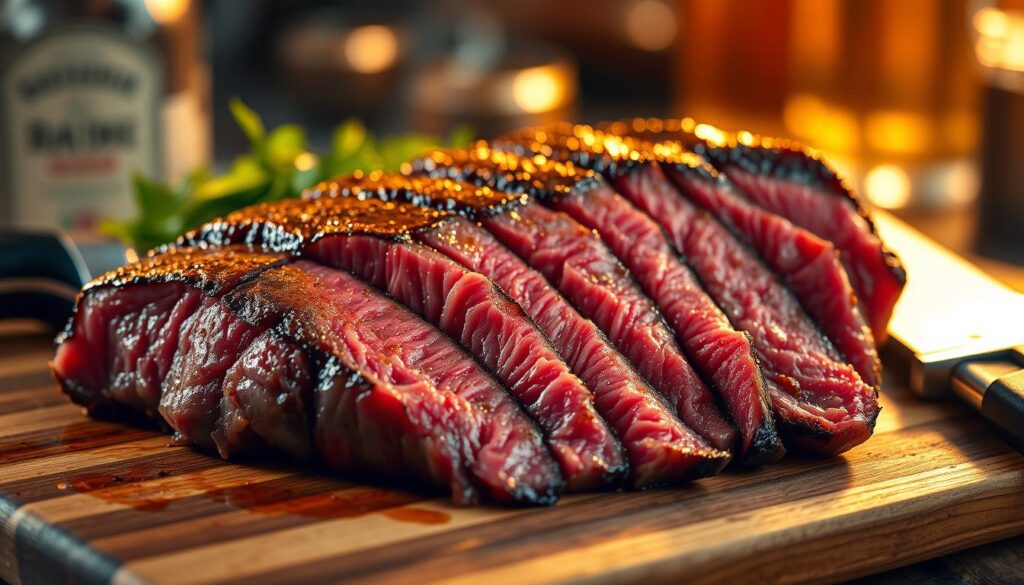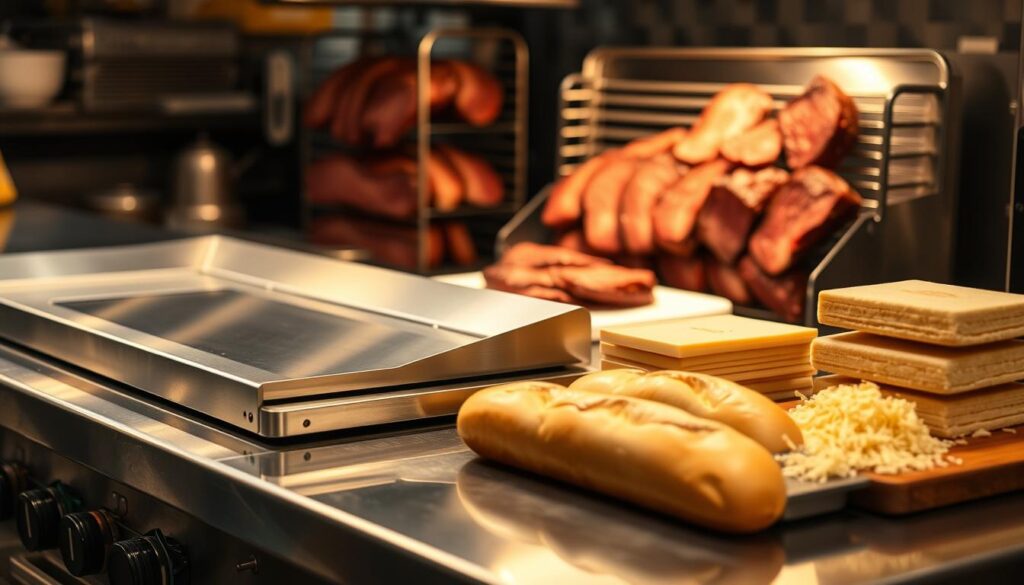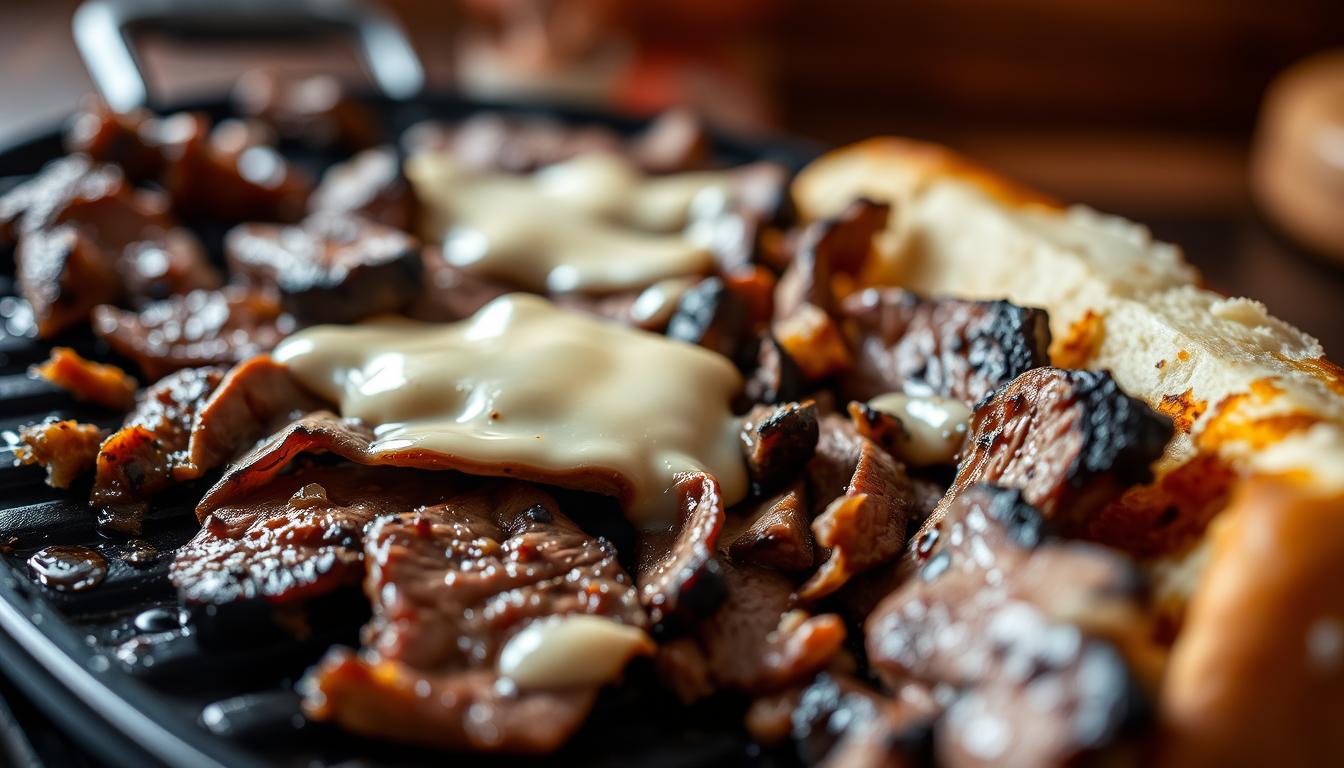Imagine biting into a tender, juicy cheesesteak. It’s filled with flavorful beef, sautéed onions, and melted cheese. You can make this deliciousness at home with the right recipes. We’ll show you how to make the perfect homemade cheesesteak.
For a real Philly cheesesteak, use a ribeye steak. It’s tender and flavorful. Visit philly cheesesteak recipe for peppers and onions. With the right ingredients and practice, you’ll be a pro at making cheesesteak beef recipes. Let’s start exploring the best recipes and techniques for the perfect dish.
The Rich History of Philadelphia Cheesesteaks
Philadelphia cheesesteaks have a long history, starting in the early 20th century. The origins of philly cheesesteak are in South Philadelphia. This is where the dish was first made.
The philly cheesesteak history is interesting. It shows how the dish changed over time. New ingredients and cooking methods were added, making the classic philly cheesesteak recipe we love today.
The first cheesesteak was sold for a nickel in the 1930s by Pat and Harry Olivieri. The classic philly cheesesteak recipe has steak, onion, and cheese on a roll. Later, grilled bell peppers and mushrooms were added, changing the dish.
Some key facts about the philly cheesesteak history are:
- Cheese was first added in the 1940s with provolone.
- Pat’s King of Steaks and Geno’s Steaks have been rivals for decades.
- Cheez Whiz became a favorite topping in the 1960s.

The origins of philly cheesesteak show Philadelphia’s rich food history. Today, the dish is a favorite in Philadelphia. Knowing the philly cheesesteak history and how it evolved helps us appreciate this iconic dish.
Essential Ingredients for the Perfect Cheesesteak
For a tasty cheesesteak, the right cheesesteak ingredients are key. A classic Philly cheesesteak has thinly sliced steak, like ribeye or top round. You’ll also need quality cheese and veggies.
The essential ingredients for cheesesteak include a 10 to 12 ounce steak. It should be as thin as possible. Provolone cheese is the go-to, with 2 ounces or 3 slices used. You can also try chicken, mushrooms, or other cheeses like pepper jack or sharp cheddar.
Here’s what you’ll need for your cheesesteak:
- 1 pound (454 g) of boneless rib eye steak or skirt steak
- 8 thin slices of provolone cheese (about 6 ounces or 160 g)
- 1 onion (approximately 4 ounces or 114 g)
- 2 tablespoons of grated Parmigiano-Reggiano cheese (optional)
- 1 teaspoon of Diamond Crystal kosher salt

With these essential ingredients for cheesesteak, you’re set for a tasty Philly cheesesteak. Choose the best ingredients and follow traditional methods for a memorable meal.
Choosing the Right Cut of Beef
Choosing the right beef for a cheesesteak is key. You want it to be both tasty and tender. Ribeye is a favorite for its rich taste and fat content. But, it can cost about $9 per pound.
Top round is a cheaper choice, priced under $6 per pound. It’s leaner, so it tastes milder and is less juicy. But, it can also make a great cheesesteak. Other good cuts include skirt, sirloin, and strip steak. The secret to a great cheesesteak is slicing the beef thinly against the grain.

When picking beef, think about marbling and thickness. Marbling adds flavor and tenderness. Thickness affects cooking time. By choosing the right cut and slicing it right, you’ll make a cheesesteak that’s unforgettable. Whether you pick ribeye or another cut, cook it to 400 to 425 degrees Fahrenheit for the best taste.
Ribeye vs Other Cuts
- Ribeye: tender, rich flavor, high fat-to-meat ratio
- Top round: leaner, milder flavor, less juicy texture
- Skirt: more fibrous texture, slightly more fat and flavor than flank steak
- Sirloin: benefits from marinades made with acidic ingredients to enhance flavor and tenderness
Proper Slicing Techniques
To get ultra-thin slices, freeze the steak for 30 minutes to 1 hour before slicing. Cut it into sections about 3 inches wide before freezing. This makes it easier to get the perfect slice for your cheesesteak.
Must-Have Equipment for Cheesesteak Success
To make a tasty cheesesteak, you need the right cheesesteak equipment. A large, deep sauté pan or a Dutch oven works well. It should handle high heat and spread it evenly.
For a great cheesesteak, you’ll also need a cutting board, sharp knife, and spatula. A meat slicer helps slice the beef thinly and evenly. You can also use a griddle or grill to cook the cheesesteak. A thermometer ensures the meat is cooked just right.
Here’s a list of the key cheesesteak cooking equipment:
- Large, deep sauté pan or Dutch oven
- Cutting board
- Sharp knife
- Spatula
- Meat slicer (optional)
- Griddle or grill
- Thermometer

With the right cheesesteak equipment, your cheesesteak will be delicious and authentic. Choose durable, easy-to-clean gear that can handle high temperatures.
Mastering Traditional Cheesesteak Beef Recipes
To make a traditional cheesesteak, you need to know the basic cooking method. First, slice the beef into thin strips. Freeze the steak for 30-40 minutes before slicing. This step is key to getting the right texture.
After slicing the beef, start cooking it. Use a pan with oil to sauté the beef until it’s browned and cooked. Seasoning secrets are important for flavor. Use salt, pepper, and other seasonings to make your cheesesteak unique.
Here are some tips for mastering a traditional cheesesteak recipe:
- Use high-quality ingredients, including ribeye steak and fresh vegetables.
- Don’t overcook the beef, as this can make it tough and dry.
- Experiment with different seasoning secrets to find the combination that works best for you.
Follow these tips and master the basic cooking method. You’ll make a delicious traditional cheesesteak. Always use fresh ingredients and try different seasoning secrets to find your favorite.
The Art of Caramelizing Onions
Caramelizing onions is key to a tasty cheesesteak. It needs patience and focus. Cooking onions slowly over low heat brings out a sweet flavor that goes well with beef. For the best caramelization, use yellow or sweet onions and cook them for 25-30 minutes until they’re golden and soft.
Here are some tips for caramelizing onions:
- Use a mixture of butter and oil to prevent the onions from burning
- Cook the onions over low heat, stirring occasionally, to prevent them from burning
- Add a pinch of salt to bring out the natural sweetness of the onions
Mastering caramelizing onions adds a rich flavor to your cheesesteak. Whether as a topping or mixed with beef, the onions make the dish unforgettable. With practice and patience, you’ll get perfect caramelization and elevate your cheesesteak.
Building Your Cheesesteak Like a Pro
Building a cheesesteak is all about the details. Start with a sturdy roll that won’t get soggy. Choose a roll with a soft inside and a crispy outside. Toast it lightly before adding the fillings.
The way you layer the ingredients is key. Begin with thin slices of meat. Then add sautéed onions and bell peppers. Sprinkle some cheese, like a mix of American and mild provolone, and finish with more meat. This balance of flavors and textures makes each bite perfect.
Want to make your cheesesteak even better? Try adding sliced mushrooms or jalapeños. Just remember to keep the flavors and textures in balance. With a bit of practice, you’ll be making cheesesteaks like a pro in no time.
Regional Variations and Modern Twists
Exploring the world of cheesesteaks reveals many regional cheesesteak variations. Each region brings its own twist to this classic dish. You can find inspiration for your own creations by checking out popular cheesesteak recipes.
Modern twists include adding bell peppers and mushrooms. These ingredients bring new flavors and textures. You can also experiment with different cheeses, like provolone or American, to create unique tastes.
Here are some popular regional cheesesteak variations:
- Philly cheesesteak: thin slices of beef, sautéed with onions and bell peppers, and served on a hoagie roll
- Chicago-style cheesesteak: a heartier version of the classic, with thicker slices of beef and a crusty roll
- California cheesesteak: a West Coast twist, featuring avocado and bacon
Whether you love the classics or enjoy trying new things, there’s a cheesesteak for you. So, why not explore the world of regional cheesesteak variations and modern twists on cheesesteak?
Common Mistakes to Avoid
Making a tasty cheesesteak can be tricky. One big mistake is not controlling the temperature right. This can make the steak too hard or too soft. To fix this, cook the steak slowly and for a longer time. This keeps it juicy and full of flavor.
Another mistake is getting the ingredients wrong. Too much or too little of anything can mess up the taste. Too much cheese can cover up the other flavors, while too little makes the dish dry. Finding the right mix of ingredients is key to a great cheesesteak.
Other mistakes include salting the steak too early, which can dry it out. Also, adding too many toppings, like bell peppers, can ruin the dish’s true taste. By watching out for these errors, you can make a cheesesteak that everyone will love.
To make the perfect cheesesteak, focus on the details. Avoid mistakes like wrong temperatures and ingredient mixes. Use top-notch ingredients and follow these tips. Then, you’ll have a cheesesteak that’s a hit at home.
Making Ahead and Storage Tips
When making ahead cheesesteak, it’s key to think about how to keep it fresh. You can chill or freeze it for later, which is great for meal prep.
For chilling, keep your cheesesteak in a sealed container for up to 5 days. Freezing it works for up to 3 months. Always heat it to 165°F when you reheat it to stay safe.
Here are some tips for storing cheesesteak:
- Refrigerate at 40°F or below
- Freeze at 0°F or below
- Use airtight containers to prevent moisture and other flavors from affecting the cheesesteak
- Label and date the containers so you can easily keep track of how long they’ve been stored
To reheat cheesesteak leftovers, use the oven or microwave. For the oven, heat at 350°F for 10-15 minutes. For the microwave, heat on high for 1-2 minutes. Check out dairy-free shredded chicken recipes for more meal prep ideas.
By using these storage tips and making ahead, you can enjoy your favorite cheesesteak whenever you like. It will stay tasty and fresh.
| Storage Method | Storage Duration | Reheating Method |
|---|---|---|
| Refrigeration | Up to 5 days | Oven or microwave |
| Freezing | Up to 3 months | Oven or microwave |
Pairing Suggestions and Side Dishes
Enjoying a delicious cheesesteak is even better with the right side dishes. Pairing suggestions for cheesesteak often include French Fries, Onion Rings, and Nachos. These add a salty, crunchy texture that goes well with the cheesesteak’s rich flavors.
There are also modern sides that can make your cheesesteak even better. Try roasted vegetable skewers, arugula salad, or crispy fried dill pickles. For a bigger side, consider beverage pairings like cold beer or lemonade to match the cheesesteak’s taste.
Here are some popular side dishes for cheesesteak:
- Ranch Roasted Potatoes
- Southern Potato Salad
- Crispy Oven Roasted Potatoes
- Chopped Kale Avocado Salad
With so many choices, you can find the perfect side dishes for cheesesteak to match your taste. Whether you like classic or modern, the right pairing can make your cheesesteak even better.
Scaling Your Recipe for Parties
Hosting a party? Serving a party-sized cheesesteak is a fantastic idea. Scaling up a cheesesteak recipe is simpler than you might think. With a few tips, you can create a large batch cheesesteak that everyone will love. Remember, the cooking time and temperature are key. Make sure your griddle is at 400–425°F (204–218°C) for perfect cheesesteaks.
To scale up your recipe, cook the steak and onions in big batches. Then, assemble the cheesesteaks right before serving. This saves time and keeps your guests happy. You can also prep Philly Cheesesteak Sliders ahead of time to ease the party prep.
Here are some tips for scaling up your cheesesteak recipe:
- Cook your steak and onions in large batches to save time.
- Assemble the cheesesteaks just before serving to ensure they’re fresh and hot.
- Consider making Philly Cheesesteak Sliders in advance to save time and reduce stress.
Follow these tips and use a large batch cheesesteak recipe for a memorable meal. Whether it’s a small gathering or a big event, a party-sized cheesesteak will be a hit. So, why not try scaling up your favorite cheesesteak recipe?
Healthier Alternatives and Dietary Modifications
Enjoying a cheesesteak doesn’t mean you have to give up taste for health. There are many healthier cheesesteak alternatives and dietary modifications for cheesesteak to cut down calories and fat. Using leaner meats like sirloin or tenderloin can greatly reduce fat.
For a low-carb cheesesteak, try using a low-carb tortilla or portobello mushroom caps instead of a hoagie roll. Adding more veggies, like bell peppers and onions, boosts the dish’s nutrition.
Other dietary modifications for cheesesteak include choosing reduced-fat cheese, like part-skim mozzarella or reduced-fat provolone. Adding hot peppers or red pepper flakes can also help increase your metabolism. With a few tweaks, you can enjoy a healthier cheesesteak alternative that’s both tasty and fulfilling.
Conclusion
Making the perfect cheesesteak is easier than you think. With the right techniques and practice, you can make a sandwich as good as Philadelphia’s. The secret is using top-notch ingredients, slicing the beef right, and finding the perfect flavor mix.
Whether you like the classic Philly-style or want to try something new, there’s always room for creativity. Feel free to mix things up and add your own twist to this favorite dish. As you keep making cheesesteaks, share them with loved ones and enjoy every bite.

